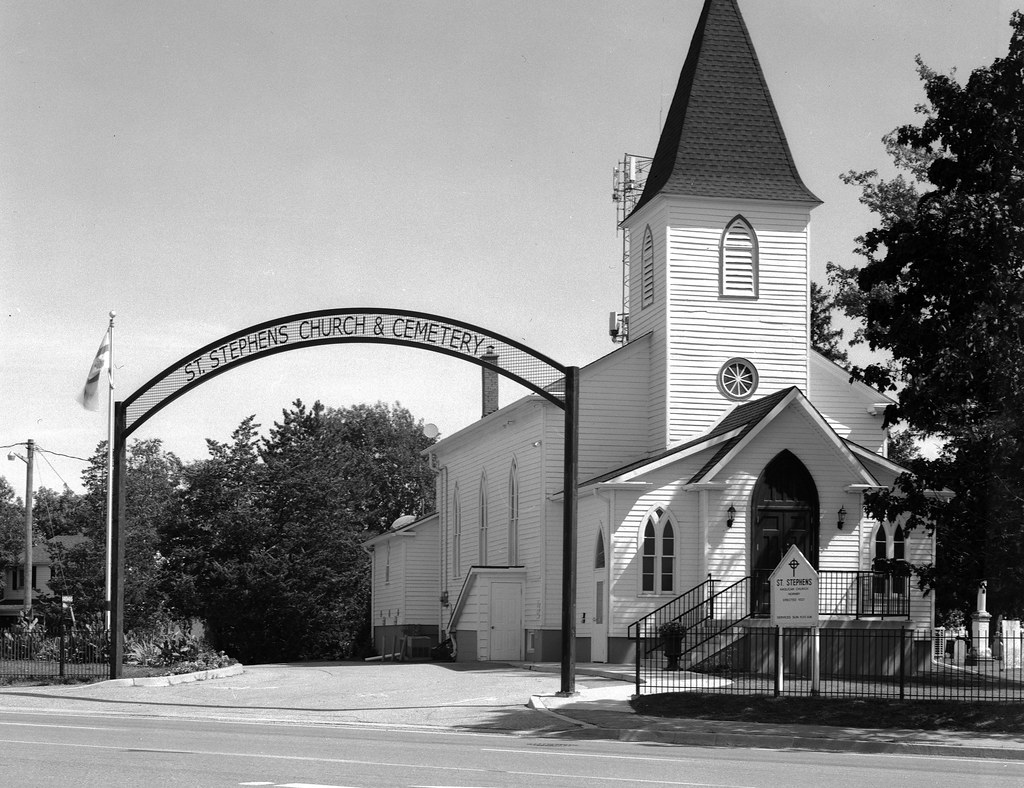Today most people visit the historical village of Hornby for the Toronto Outlet mall. But this tiny village was once home to a thriving community with a large church presence. And while all have since closed, there is still one that stands tall, St Stephen’s Anglican Church.

In 1834, Rev Adam Elliot led the first recorded Anglican service in Hornby. Rev Elliot, known for his work with Canada’s Indigenous peoples, was one of many missionary rectors who served the many Anglicans who lived in the rural parts of Upper Canada. These services continued in Hornby, hosted at farms through the settlement and, as attendance grew, called for a proper church building to be established. John Cowin donated a section of his property to establish a meeting house and burial ground. From 1835 to 1837, a simple wooden frame church was built by volunteers using donated materials. The sanctuary was unique because it sat at an angle to the property line so that they faced east on simple benches when the congregation was seated. The rector, Rev Francis Reyman, petitioned Bishop Strachan to concrete the church in 1862. A small office and vestry were added in 1869, and the sixty-foot steeple and bell tower were added in 1875. In 1889 a basement was added, and the church was raised onto a new foundation; gas lamps, proper box pews, and wainscoting were added to beautify the sanctuary. Additionally, a new chancel, alter, and choir loft was added. In 1930, the churchyard was better landscaped, and additional property was added to expand the cemetery. The gas lighting was replaced by electrical lights in 1951, and a parish hall was added in 1953. The older pump organ was replaced in 1958 with a modern electrical one. The current lynch gate, a replica of the original entrance, was installed in 1966. Through the 1970s, a series of renovations restored elements of the sanctuary, including installing some of the original gas fixtures (for decorative purposes), restoration completed on the organ and some of the stained glass. Despite the decline of Hornby, St. Stephens has remained an active and vibrant rural parish. The church is unique because it retains its historical elements and has changed little over many years of service.
The problem with St. Stephen’s is twofold; the first is the angle it sits with Steeles Avenue, which makes it difficult to photograph from the church property itself. Instead, I went across the road using the 210mm lens to fill the frame. I composed the image to get a good angle of the front of the church, including the 1966 lynch gate. I also had to wait for a traffic gap, which can be problematic during rush hour.
If you wish to worship with this congregation, they will be happy to welcome you! Please check out the congregational website for details on attending services worship either in-person on online streaming!
Web: churchonsteeles.weebly.com
Facebook: facebook.com/churchonsteeles
Instagram:
YouTube:
Hi Alex,
I am compiling a book on the Early Churches of Trafalgar Township, Halton County for my genealogy group, Halton-Peel Branch of The Ontario Genealogical Society. I would like to add this blog you wrote about St. Stephen’s Anglican Church giving you full credit of course. If permission is granted, then many thanks.
Regards,
Kathy Baker
Mississauga, ON
I would be honoured! Please consider my permission given! Alex